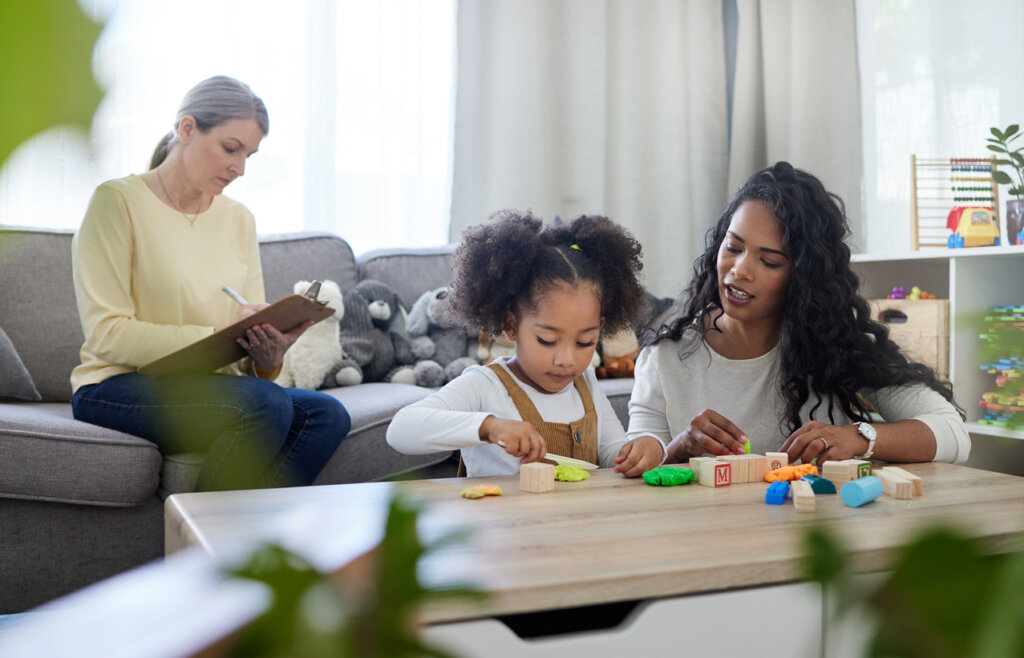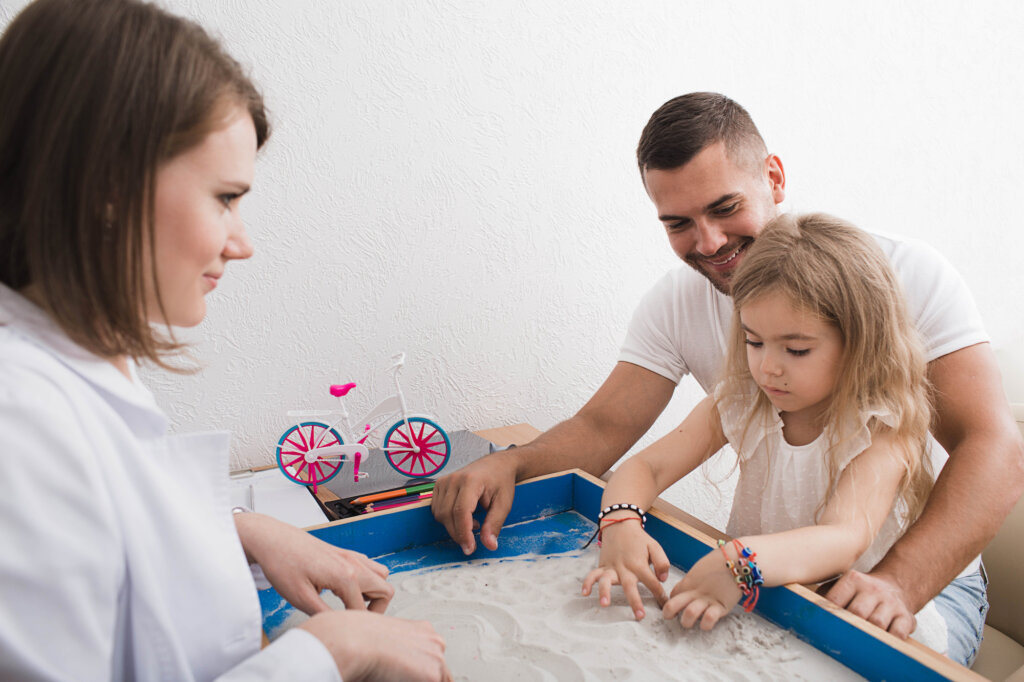Filial Therapy: Helping Children Through Play


Written and verified by the psychologist Elena Sanz
To improve a child’s behavior or understand their problems, the traditional solution is to see a child psychologist. But, what if the caregivers themselves were to develop this approach? In fact, sometimes, while the guidance and support of an expert might be necessary, there are certain tools parents can use to listen, understand, and support their children at home. This is what filial therapy proposes.
Filial therapy isn’t new. It was developed in the 1960s by Bernard and Louise Guerney. These two psychologists were leaders in the field of play therapy. They created filial therapy as an alternative intervention. It was aimed at designating the main caregivers as therapeutic agents.
Filial therapy
To understand filial therapy, we must understand the importance of play for children. Play is their natural habitat, their means of expression, and the way in which they learn about the world around them. Indeed, playing with a child is the ideal opportunity to get to know them and transmit ideas and values to them. Above all, to connect with them.
This is why professionals who work with children use games as evaluation, diagnosis, and intervention techniques. Schaefer (2012) refers to VanFleet in Chapter Nine of the book, Foundations of Play Therapy, stating that filial therapy has certain peculiarities. They’re as follows:
- The primary caretakers are therapeutic agents. They direct play sessions with their children.
- The therapist fulfills the role of educator or coach. They instruct the parents and provide them with information and instructions so that they can carry out the therapy themselves.
- Play sessions are held at home. Parents employ all the techniques they’ve learned at home. They also extrapolate them to other daily situations with their children.
- The play sessions can continue even after the therapy is complete. Indeed, they’re moments of enjoyment and connection for both children and adults.
- The atmosphere generated during the play sessions is, in itself, therapeutic. In fact, it’s considered that, beyond its goals in this particular context, this safe space of communication, acceptance, and empathy also has its own benefits.
How filial therapy is employed
Now that you know the basics of this approach, we’re going to explore how it’s put into practice. It has three phases.

1. Caregiver training
In the first stage, parents meet with the therapist and present their case to them. The professional evaluates the family dynamics and their way of relating and then moves to the process of psychoeducation. This is to guide parents on their parenting styles and the therapy in question.
In addition, the specialist trains parents in certain essential skills and basic techniques necessary to undertake the play sessions. They also carry out play sessions with the child that the parents can observe.
Afterward, the caregivers take charge of directing the play sessions, while the professional observes and supervises. They subsequently offer feedback and comments on any aspects that might be improved.
2. Play sessions at home
Once parents feel safe to carry out the therapy on their own, they begin the play sessions at home. These are developed with one parent and child at a time so that the dedication is personalized and the care is of the highest quality. The therapist also follows up and monitors their progress.
3. Download
Finally, the specialist helps parents to transfer what they’ve learned to other contexts. As a matter of fact, the basic skills used in filial therapy (such as emphatic listening, imaginative play, or setting boundaries) are also useful in other situations of daily family life.
An article published in the Australian and New Zealand Journal of Family Therapy claims that this type of therapy allows parents to offer a balance between acceptance and emotional nurturing on the one hand, and the healthy setting of boundaries on the other.
In the last stage of filial therapy, parents can meet in groups with other parents who are also practicing it. This means they can share experiences, compare their impressions of the therapy, and strengthen their learning.
Benefits of filial therapy
This type of approach is ideal for many families and provides several benefits. These are described in an article shared in 2015 by the International Journal of Play Therapy. They’re as follows:
- It offers the child a safe framework to express themselves and share with their parents their inner world, their longings, fears, and desires.
- It allows parents to connect with their child, understand them, and improve their listening and communication skills. Thus, a relationship of trust is created between the two.
- It strengthens family ties and helps the child feel listened to and cared for. This can prevent self-esteem problems or behavioral disorders.
- It helps the parent and child practice different problem-solving and communication skills and learn to manage frustrating situations.
Thanks to the above-mentioned reasons, filial therapy is a suitable alternative for families who want to strengthen their ties, for groups at risk that need to work on empathy and communication, and for families with specific problems.
For example, according to a review published in 2005 by the American Psychological Association, filial therapy has been used successfully in the treatment of affective and anxiety disorders, conduct problems, learning disorders, and traumatic experiences.

Final recommendations
If, after reading the above, you consider that filial therapy may be a good option for you and your family, it’s worth bearing the following in mind. Firstly, it’s a relatively brief technique. In fact, it usually consists of around 15 to 20 sessions that last between three and six months in total.
Secondly, filial therapy is an intervention designed for children between three and twelve years of age. Before that time, the child’s maturational stage won’t allow them to adequately engage in imaginative play. And, beyond this age, conversational interventions are preferable.
Finally, filial therapy promotes free and undirected play. Therefore, the child sets the pace and the adult follows. This allows for expression, development, connection, and changes to be generated. If you want to participate in this kind of therapy, visit a child therapist with experience in the field of play therapy.
To improve a child’s behavior or understand their problems, the traditional solution is to see a child psychologist. But, what if the caregivers themselves were to develop this approach? In fact, sometimes, while the guidance and support of an expert might be necessary, there are certain tools parents can use to listen, understand, and support their children at home. This is what filial therapy proposes.
Filial therapy isn’t new. It was developed in the 1960s by Bernard and Louise Guerney. These two psychologists were leaders in the field of play therapy. They created filial therapy as an alternative intervention. It was aimed at designating the main caregivers as therapeutic agents.
Filial therapy
To understand filial therapy, we must understand the importance of play for children. Play is their natural habitat, their means of expression, and the way in which they learn about the world around them. Indeed, playing with a child is the ideal opportunity to get to know them and transmit ideas and values to them. Above all, to connect with them.
This is why professionals who work with children use games as evaluation, diagnosis, and intervention techniques. Schaefer (2012) refers to VanFleet in Chapter Nine of the book, Foundations of Play Therapy, stating that filial therapy has certain peculiarities. They’re as follows:
- The primary caretakers are therapeutic agents. They direct play sessions with their children.
- The therapist fulfills the role of educator or coach. They instruct the parents and provide them with information and instructions so that they can carry out the therapy themselves.
- Play sessions are held at home. Parents employ all the techniques they’ve learned at home. They also extrapolate them to other daily situations with their children.
- The play sessions can continue even after the therapy is complete. Indeed, they’re moments of enjoyment and connection for both children and adults.
- The atmosphere generated during the play sessions is, in itself, therapeutic. In fact, it’s considered that, beyond its goals in this particular context, this safe space of communication, acceptance, and empathy also has its own benefits.
How filial therapy is employed
Now that you know the basics of this approach, we’re going to explore how it’s put into practice. It has three phases.

1. Caregiver training
In the first stage, parents meet with the therapist and present their case to them. The professional evaluates the family dynamics and their way of relating and then moves to the process of psychoeducation. This is to guide parents on their parenting styles and the therapy in question.
In addition, the specialist trains parents in certain essential skills and basic techniques necessary to undertake the play sessions. They also carry out play sessions with the child that the parents can observe.
Afterward, the caregivers take charge of directing the play sessions, while the professional observes and supervises. They subsequently offer feedback and comments on any aspects that might be improved.
2. Play sessions at home
Once parents feel safe to carry out the therapy on their own, they begin the play sessions at home. These are developed with one parent and child at a time so that the dedication is personalized and the care is of the highest quality. The therapist also follows up and monitors their progress.
3. Download
Finally, the specialist helps parents to transfer what they’ve learned to other contexts. As a matter of fact, the basic skills used in filial therapy (such as emphatic listening, imaginative play, or setting boundaries) are also useful in other situations of daily family life.
An article published in the Australian and New Zealand Journal of Family Therapy claims that this type of therapy allows parents to offer a balance between acceptance and emotional nurturing on the one hand, and the healthy setting of boundaries on the other.
In the last stage of filial therapy, parents can meet in groups with other parents who are also practicing it. This means they can share experiences, compare their impressions of the therapy, and strengthen their learning.
Benefits of filial therapy
This type of approach is ideal for many families and provides several benefits. These are described in an article shared in 2015 by the International Journal of Play Therapy. They’re as follows:
- It offers the child a safe framework to express themselves and share with their parents their inner world, their longings, fears, and desires.
- It allows parents to connect with their child, understand them, and improve their listening and communication skills. Thus, a relationship of trust is created between the two.
- It strengthens family ties and helps the child feel listened to and cared for. This can prevent self-esteem problems or behavioral disorders.
- It helps the parent and child practice different problem-solving and communication skills and learn to manage frustrating situations.
Thanks to the above-mentioned reasons, filial therapy is a suitable alternative for families who want to strengthen their ties, for groups at risk that need to work on empathy and communication, and for families with specific problems.
For example, according to a review published in 2005 by the American Psychological Association, filial therapy has been used successfully in the treatment of affective and anxiety disorders, conduct problems, learning disorders, and traumatic experiences.

Final recommendations
If, after reading the above, you consider that filial therapy may be a good option for you and your family, it’s worth bearing the following in mind. Firstly, it’s a relatively brief technique. In fact, it usually consists of around 15 to 20 sessions that last between three and six months in total.
Secondly, filial therapy is an intervention designed for children between three and twelve years of age. Before that time, the child’s maturational stage won’t allow them to adequately engage in imaginative play. And, beyond this age, conversational interventions are preferable.
Finally, filial therapy promotes free and undirected play. Therefore, the child sets the pace and the adult follows. This allows for expression, development, connection, and changes to be generated. If you want to participate in this kind of therapy, visit a child therapist with experience in the field of play therapy.
All cited sources were thoroughly reviewed by our team to ensure their quality, reliability, currency, and validity. The bibliography of this article was considered reliable and of academic or scientific accuracy.
- Cornett, N., & Bratton, S. C. (2015). A golden intervention: 50 years of research on filial therapy. International Journal of Play Therapy, 24(3), 119. https://www.researchgate.net/publication/276087220_A_Golden_Intervention_50_Years_of_Research_on_Filial_Therapy
- Guerney, B., Jr. (1964). Terapia filial: descripción y justificación. Revista de Psicología Consultiva, 28 (4), 304–310. https://psycnet.apa.org/record/1965-05407-001
- Schaefer, C. E. (2012). Fundamentos de terapia de juego. Editorial El Manual Moderno. https://books.google.es/books?hl=es&lr=&id=js3HCQAAQBAJ&oi=fnd&pg=PA153&dq=terapia+filial&ots=D3h9rrlUsd&sig=_QGW7ymuy82RGY2X-H5iQ-CK03c#v=onepage&q=terapia%20filial&f=false
- Topham, G., & VanFleet, R. (2011). Filial Therapy: A Structured and Straightforward Approach to Including Young Children in Family Therapy. Australian and New Zealand Journal of Family Therapy, 32(2), 144-158. https://www.researchgate.net/publication/259418863_Filial_Therapy_A_Structured_and_Straightforward_Approach_to_Including_Young_Children_in_Family_Therapy
- VanFleet, R., Ryan, S. D., & Smith, S. K. (2005). Filial therapy: A critical review. In L. A. Reddy, T. M. Files-Hall, & C. E. Schaefer (Eds.), Empirically based play interventions for children, 241–264. American Psychological Association. https://scholar.google.co.ve/scholar?q=Filial+therapy:+A+critical+review&hl=es&as_sdt=0&as_vis=1&oi=scholart#:~:text=Crear%20alerta-,%5BPDF%5D%20academia.edu,-Filial%20therapy%3A%20A
This text is provided for informational purposes only and does not replace consultation with a professional. If in doubt, consult your specialist.







